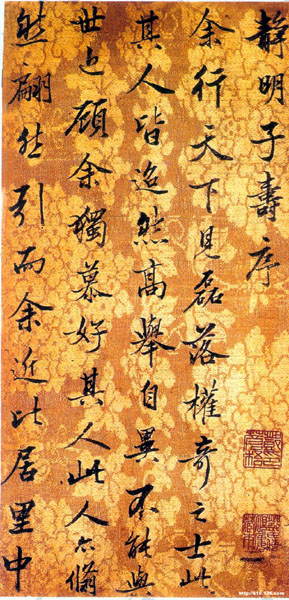Chen Tingjing (1641-1712) was a native of Zezhou, Shanxi. His first name was Jing, the word Ziduan, and the word for rock, he was named Wuting. He is a novice calligrapher in the Qing Dynasty. He was a scholar in the fifteenth year of Shunzhi. He served as the president of the Hadith, Unification History, and Ming History in the three dynasties, and was an official in Wenyuange University. Both poems and calligraphy are extremely meticulous, and the ancient essays made are appreciated by Wang Wan, and the poems are also amazing by Wang Shizhen. The posthumous posthumous title Wenzhen. "Zunwen Pavilion Collection (尊闻阁集)" was released, and it was hand-written as "Wuting Wenbian (午亭文编)" in his later years.
Chen Tingjing was a representative calligrapher with profound knowledge of calligraphy in the early Qing Dynasty. This frame "The Preface of Jing Ming Zi's Birthday (静明子寿序)" is his very typical representative work.
First of all, from the perspective of the whole work, it can be seen that Chen Tingjing has worked very hard on the "Lanting Preface (兰亭序)" by Wang Xizhi, the book sage of the Eastern Jin Dynasty. Characters such as "Shou, Luo, Qi, Tiao, Mu, Yu" are written very lightly and skillfully; in addition, the strokes of words such as "Ming, Preface, This, Difference, And, Qi" Compared with the "Lanting Preface (兰亭序)", it can be described as vivid and vivid; the rest, turning and closing methods of the words "Jie, No, Shi, Gu, and this" are all typical "Lanting Preface" strokes. It is not an accidental phenomenon that Chen Tingjing has a soft spot for Wang Xizhi. This is not only affected by the general climate of the early Qing dynasty, but also related to its own professional characteristics. As an intellectual serving the people of the dynasty, he chose to study calligraphy either in rigorous regular script, such as the big script in the Tang Dynasty, or the Jin people's running script with strong calligraphy, style and shape. He chose the latter, which helps him to review and record a large number of manuscripts more quickly. The writing speed of "The Preface of Jing Ming Zi's Birthday (静明子寿序)" is not hurried or slow, and it has a strong scent of scrolls.
Secondly, Chen Tingjing did not just copy the creation method of "Lanting Preface (兰亭序)". Many fonts in this work are tight in the middle palace and slender body. Obviously they were influenced by Ouyangxun’s running script "Luohua Shi Tie" in the early Tang Dynasty, such as "Xing, Luo, Ju, Shi, Mu, Ju," The words "li, middle" are exquisitely written, showing the spirit of rigor. Not only that, but the shadows of Zhao Mengfu in the Yuan Dynasty and Wen Zhengming in the Ming Dynasty can be seen in the works, such as the structure and the rhythm of the strokes of the characters "Xu, Ran (line 3), Neng, Xiu, Er", and so on. "No, and, near, and Ran (line 5, 3 yu)" method of continuous writing and
The “cutting of the brush” when the brush is stopped (the brush is lifted from the side and then stopped, there is no phenomenon of procrastination), which is very similar to Wen Zhengming's running script works.
It can be said that Chen Tingjing is a master of calligraphy in the early Qing Dynasty. In "Jing", we can appreciate his highly refined and ingenious use of the calligraphy techniques of the past dynasties. It is said that when he was the assistant minister of the staff in the Kangxi period, he was also in charge of the money method of the household department. This shows that he is very good at analyzing reality and putting forward shortcuts to problems. This method is also applied to calligraphy. He knows how to get his own place in the face of the style of competition and calligraphy, and how to abandon and absorb it for his own use.
In general, although the "Preface to the Life of the Jing Ming Zi" is a fusion of the methods of many families, the work is relaxed and free, and the brushwork is proficient, without fail. However, from a creative point of view, this work is insufficient, because it is difficult for us to find a creative language (element) belonging to Chen Tingjing's own work. From the perspective of the brushwork and the structure of the characters, we stay in the right place. It's hard to say how creative it is at the stage of comprehensive application of human brushwork. When talking about the shaping of typical characters in literature, Lu Xun said, "Choosing a hundred schools of thought and combining them into one", but calligraphy has more "rigorous" requirements. If the calligrapher himself does not have personality characteristics and a rich and colorful life that is very different from others. His works will not have the deafening effect of the times.
Even so, Chen Tingjing is still an outstanding calligrapher of skill. He avoided the dead end of calligraphy (guange style) and chose a path of calligraphy that was most suitable for him, and reached a very perfect state. This is very rare.
After the Qing Dynasty and the Chinese dynasty, there will no longer be a calligraphy work that has been so skillfully applied to the "Lanting Preface (兰亭序)" of the Jin Dynasty and the techniques of the early Tang and Yuan and Ming dynasties like the "The Preface of Jing Ming Zi's Birthday (静明子寿序)". The scholarship is full of new vitality.

Appreciation and Analysis of Chen Tingjing's "Preface to the Preface to the Child's Life in Jingming (静明子寿序)"








